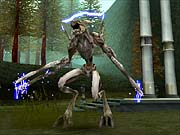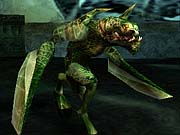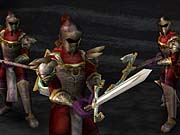Soul Reaver 2 Q&A
We talk with Crystal Dynamics' Amy Hennig about the last phases of this much-anticipated game's development.
Few sequels have been more anticipated than the original Soul Reaver's. Similarly, few games have endured as many changes during their development than its eventual sequel. With not only a platform change, but also a Dreamcast-cancellation under its belt, the developers found themselves on square one more than once during the game's cycle. All of these hurdles contributed to a long wait indeed for the series' fans. And they've been quite vocal about it.
Much of this has to do, no doubt, with the original's cliffhanger ending. However, the fact that its fans invested so much into the series' unfolding narrative in the first place is evidence that there is some good stuff going on at Crystal Dynamics. The wait, in any event, will soon be over--Eidos surprised us all with an October 31 release date, recently, which brought Raziel into our minds sooner than we had anticipated. In light of this, we sought out Amy Hennig, the Crystal D's Director on Soul Reaver 2, and talked to her at length about the project's final phases. What she said will definitely shed some light on this exciting project's long awaited result.
GameSpot: First of all, how does it feel to have finished this enormous and anticipated project?
Amy Hennig: Very odd. I don't think the team can quite believe it yet. It's like running a marathon and then suddenly you've crossed the finish line--you're done, but reflexively you feel like you're still supposed to be sprinting. It'll take a little while for it to settle in.

Finishing the game has been very satisfying, much more so than last time. We've all been so focused on the tasks at hand that there were times we not only lost the forest for the trees, but also lost the trees for the bark. When you're working insane hours just trying to get through all the discrete tasks that need to get done, you sometimes forget to look up and see how the whole thing is coming together.
It becomes a matter of faith, like working on a jigsaw puzzle upside down--you can see that the individual pieces fit together, but not necessarily the picture that is forming. For most of us, I think, it was a revelatory moment to stop, get a little distance, and finally see the "gestalt" of the game as the final pieces came together.
GS: The game has definitely been in the works for a long time. What can you say to fans of the game who felt they were perhaps forced to wait too long?
AH: I'm glad to address this. Soul Reaver 2 hasn't been in development as long as people think--it's basically been two years since we finished up Soul Reaver (including the PC and Dreamcast ports, and all the foreign versions that had to be completed following the US release of Soul Reaver on the PlayStation). A two-year development cycle is pretty normal or even aggressive by today's standards--if you look at some of the other big sequels coming out this season, for most, it's been almost three years since the previous installment.
But the Soul Reaver 2 team also had an extra handicap, which I don't think most people realize--the game was originally slated to be a PlayStation title, and we didn't get the go-ahead to switch to the PS2 until May of '00. This was after a three-week effort where we put together a proof-of-concept/technology demo for E3. Based on this demo, we got Eidos' approval to drop the PlayStation development and move to the PS2.
So here we were, with our little cobbled-together, behind-the-scenes demo, at the same E3 where MGS2 stole the show with its video premiere, and not only did we feel like Soul Reaver 2 needed to compete with MGS2, but we were expected to be out months earlier.

We came back from E3 2000 full of enthusiasm, but wondering how in hell we were going to pull this off. We had to scrap all the work we had done on the PlayStation version and start from square one. And with only a four-man programming team, we had to write a PS2 game engine basically from scratch, while still incorporating the more ambitious technical elements at the core of the Soul Reaver engine's design--most specifically, the continuous-data-streaming and terrain-morphing technologies that made Soul Reaver so unique.
To make a long story short(er), we created Soul Reaver 2, from the ground up, in just 17 months. This required a heroic effort, remarkable dedication, and sickening hours from the team. I am so proud of my teammates, and I'm blown away by what they've been able to accomplish in this short amount of time. I believe we've succeeded at creating a deep, compelling, technologically ambitious product, more than capable of competing with the big-budget multiyear titles coming out at the same time.
Now, this doesn't mean I'm writing off the complaints and frustrations of the fans. I believe it's the responsibility of the developer and publisher to not announce release dates until they're solid--otherwise you're just toying with the hopes and expectations of your fan base. For this, I think we owe our fans an apology and gratitude for their loyalty and patience.

GS: How do you feel the game competes with what's currently out there in the action-adventure category?
AH: Honestly, I believe Soul Reaver 2 easily holds its own among the current crop of amazing action-adventure titles out there. Which is a huge coup for the team, given our comparatively short production schedule. If anything, we tend to be overcritical of our own work, so I can tell you that I wouldn't even be doing this interview if I didn't feel pride and enthusiasm for the final product.
We knew the competition we'd be up against, so we deliberately set the bar very high. For instance, we decided early on that it would be unacceptable for the game to run at less than 60 frames per second, so we tailored the game content to meet this requirement. We knew that we had to revamp the combat system, design a greater variety of enemies, construct larger and more ornate environments, and provide more-unique and more-elaborate puzzles. There are games that are glitzier, or that surpass Soul Reaver 2 in one aspect or another, but I believe we've succeeded at creating an overall experience that rivals the best of our competition.
What really sets Soul Reaver 2 apart from its competitors, I think, is its substance--the story, characters, cinematics, and voice acting. We knew from the beginning that we were going to have to pick our battles, that we couldn't necessarily compete in all aspects with some of these other blockbuster projects that had been in development for years. The real substance of the Legacy of Kain series has always been its story, and everything else must proceed from this core.
There are a lot of games out there that are superficially beautiful but have no depth--they're all surface and no heart. My greatest hope is that we have provided an immersive, thoughtful, complex experience that respects the player's intelligence. To my mind, games are as legitimate a medium as film, television, or literature. We sell ourselves and our audience short if we write our own medium off as nothing more than a trivial diversion.
GS: Were any of the game's features cut out in order for it to meet its scheduled release?
AH: Yes, this always happens over the course of a game's development, particularly when a project has had as many twists and turns as this one. When we first switched to the PS2, we had to cut the feature list way down just to give our small programming team time to write the game engine.

And as production progressed, we realized that we had vastly underestimated how long it took to create PS2-level content--especially the creation, texturing, and lighting of the levels--compared with the PlayStation. Soul Reaver 2's terrain has at least 10 times more polygonal detail, and we discovered that it was taking us three to five times longer to build, texture, and light these environments. By the end of the project, we developed many strategies to speed the process up, but there was definitely a large and unanticipated learning curve.
So yes, we had to simplify or eliminate many of the mechanics we had originally spec'd and delete some of the levels we really had our hearts set on. The shift to the PS2 definitely came with a cost, but we felt that it was worth it--as long as we made the cuts early enough and retained the elements we felt were fundamental to the franchise (for example, story and dialogue, character development, and fluidity of gameplay).

GS: Conversely, were there any last-minute additions that you didn't think would make it?
AH: Absolutely. The team went through some collective bleak periods over the course of development, when it seemed that the game might become terribly compromised because of our aggressive schedule. We were determined to create a compelling game experience that would surpass Soul Reaver and rival our competitors on the PS2, but sometimes it felt as though the odds were just too stacked against us.
As I mentioned earlier, I think it was a bit of a revelation for the team to step back and finally see the pieces all coming together. We were able to do some final polish work on the environmental lighting, and the texturing and lighting of the character models, which made a huge difference in the overall aesthetic quality of the game. We also kept tuning the combat mechanics and the enemies right up to the end, so the game improved by leaps and bounds in this regard as well.
I would say, though, that the game made its greatest strides in the areas of dialogue and cinematics. We recorded the dialogue fairly late in development, and therefore got a late start on the cinematics. Despite this setback, our small team of four very talented animators, with implementation help from a few dedicated scripters, created over two hours' worth of compelling, richly animated cinematic sequences in just a handful of months.
Finally, in terms of last-minute additions, we decided very late in the game to make this a special-edition disc, since we had the room on the DVD. We had this huge accumulation of artwork, stills, back story documents, and so on, and we had photos and more than 10 hours of video footage from the voice sessions. So we decided that while the team was tackling the final bug fixing, we'd take the time to put these bonus materials together and include them on the disc--it's sort of an added-value "thank you" to the fans who have waited so patiently for Soul Reaver 2.
GS: Looking back, did the game turn out as you guys thought it would? Which concepts evolved in favorable ways? Any that you wish you had time to elaborate on?
AH: Well, I'd say we initially set off to create a fairly different game. The early design was overambitious and, in hindsight, would have been far too broad and shallow. The move to the PS2 and our limited schedule forced us to concentrate on the game's core elements--story, characters, combat, and environmental immersion--which in the end, I think, yielded a tighter and more focused game.
Because we had to think strategically about our limited production schedule, many of the game's core elements developed in ways that we wouldn't have foreseen, but ultimately turned out to be favorable. We were worried, for instance, about how to pull off the whole time-travel aspect of the game, which was central to the story but seemed overambitious. Out of necessity, our programmers and technical artists came up with clever strategies to address the problem, and because of this focused effort, the idea ended up being more efficient and effective--both technically and conceptually--than we had initially envisioned.

Also, as certain features fell by the wayside, other aspects of the game became more crucial. We knew, for example, that the combat mechanics and AI in Soul Reaver 2 had to be more complex and satisfying than in Soul Reaver. After a combined effort from animation, programming, and design--and with tons of feedback from our awesome test department-- Soul Reaver 2's combat system turned out to be very fun and satisfying. It's accessible for players who just want to button-mash, but it also incorporates a "deep" system of dodges, blocks, combos, and counterattacks and rewards tactical gameplay.
Finally, as we focused down onto the game's core elements, it became increasingly clear that the story, dialogue, and cinematic sweep of the game had to carry the game even more than we originally imagined. It took months to weave all the disparate historical and mythological threads together, but I think it all came together in a way that will be compelling and unexpected. And in this regard, I can't praise our voice directors, actors, and animators enough--while I'm proud of the game's story and dialogue, they deserve all the credit for bringing Soul Reaver 2's story to life.
Of course, there are dozens of features we would have liked to include or improve upon, but again, we felt compelled to pick our battles. Most of these elements are slated to be included in Soul Reaver 3--now that our game engine is in place, we can really concentrate on the features and mechanics that would have been luxuries this time around.
GS: Does finishing this project give you any perspective as to the future happenings of Nosgoth? Care to clue us in?

AH: Sure, but it'd be silly of me to divulge anything at this point. Let's just say that Soul Reaver 2 ties up a lot of long-standing questions and loose ends, but it introduces many more to be addressed in Soul Reaver 3.
And honestly, I don't have every little thing worked out yet. This is going to sound hokey, but to some degree you just have to let go, let the story tell itself, and follow the characters where they take you. There are scenes that I set out to write one way, and by the time I was finished, the interaction between the characters had gone in a completely different direction. If you try to nail everything down and dissect it, I think you kill it--you have to leave room for inspiration.
GS: Any chance of seeing Soul Reaver 2 on other platforms?
AH: We've just completed the PC version of the game, which will be out shortly (it will be available in both the US and Europe). As far as consoles go, though, Soul Reaver 2 is available exclusively on PlayStation 2.
GS: Finally, do you have any words for the fans of this long-awaited game?
AH: Throughout development, one of the constant challenges has been how to make a game that appeals to the die-hard Legacy of Kain fans and satisfies their desire for story consistency and depth, yet doesn't alienate players who are new to the series.
Based on early feedback, I think we may have successfully straddled that fence. I want to assure our loyal fans that Soul Reaver 2 is thoroughly steeped in Nosgoth's history and mythology, even down to the smallest details. The game is deeply story-based, with as much dialogue as both Soul Reaver and Blood Omen: Legacy of Kain combined. And while the game's plot doesn't require an in-depth familiarity with the Legacy of Kain mythos, I would say it definitely provides a deeper story experience for those who have been following Kain's story from the very beginning.
Got a news tip or want to contact us directly? Email news@gamespot.com
Join the conversation